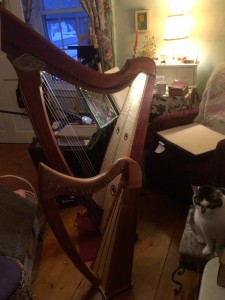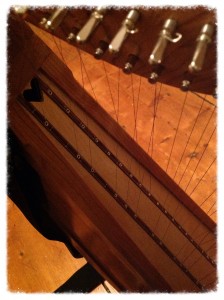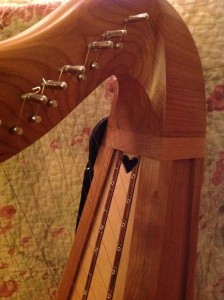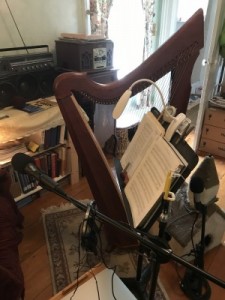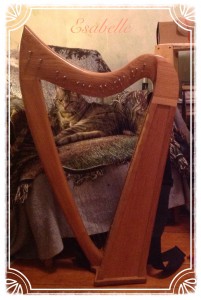Here are my two Irish wire strung harps. I have a page on my main site with a little bit more detail about them but I’ll post a few mentions here about them as well.
Here’s an up-close shot of Esabelle, my newest harp, built in 2015 by Stoney End Harps of Red Wing, MN:
This is a lap harp and being fully chromatic doesn’t require any blades or levers. One side of the neck has all the black key notes you’d find on the piano, crossing in the middle of the harp and the other side of the neck has all the white key notes, again crossing in the middle to the opposite side.
I did use paint markers on the F’s and C’s to make it easier to see the strings though… the usual red C’s and blue F’s. With a cross strung wire harp the last thing you want to do is make it harder on yourself!
And here’s a pretty little heart at the top of the sound board:
I should mention that I had this harp built shortly after losing my beloved 14 year old rescue kitty Isabelle (Donella Kitty’s mom) to diabetic ketoacidosis, although I’d been giving her insulin twice a day for two years. Her paw print impression and photo are inside the harp.
This is a good size comparison of the two harps. I do have a harp cart for my Triplett Luna but haven’t needed to move it too much. Portability is another reason why I chose a lap harp for my second harp. A few times I took the Luna outside on a nice summer’s day. It was enjoyable, but it really got me thinking a lot about lap harps! Especially at the end of the day when it was time to move her back up the long carpeted stairway…
As you can see, I don’t move my bigger harp much. I do admire orchestra harpists! Your instruments are bigger and heavier. And they have to be moved. Often.
The two harps have become quite tuning stable over time. Contrary to all the scare stories you may have heard (read) about wire harps popping their strings, etc, they’re not that much more temperamental than any other harp. I don’t have to tune Esabelle that often. The Luna has a few pins that slip when the humidity goes up in the summer and so a wire or two may go abruptly slack but it will go back to full tension immediately without breaking.
I do have both of them tuned to A415, not today’s concert pitch standard of A440. It’s much easier on the sound board and the wires, and I have fewer breakages that way. As they’re both used for recording purposes, pitch correction is easily taken care of in the studio, especially when I have a synthesizer backing track. And of course, A415 is a half-tone difference from A440 anyway, so I just think of them as playing in a different key! (or mode?)
They each have a very different voice and they handle differently. When I first got Esabelle, it took me some time to adjust going back and forth between each harp because their characteristics are so different, and not just because one of them is a cross-strung! Their ringing sustains are different, timbre is unlike the other and even their wire metallic composition is different: copper phosphor bronze for Luna, steel strings for Esabelle. String spacing is also a hair wider on one than the other and likewise the string thickness.
I love playing a wire harp. I’ve tried nylon-strung Celtic harps. They’re nice, but they’re don’t speak to me the way the way the wire-strung ones do. The first time I heard a wire harp was when I was doing harp research for my undergraduate music degree at Green Mountain College (I was studying pipe organ then). I heard a recording of an Irish wire-strung harp and just fell in love with the sound. Unfortunately, because I was overwhelmed with school work at the time, I don’t remember who the recording artist was or what the piece was, but I do remember returning to it the next day when my studies were finished and playing it over and over again. I started realizing then I probably wasn’t going to stay with the organ much longer and there was going to be a wire harp (or two or three) in my future.

